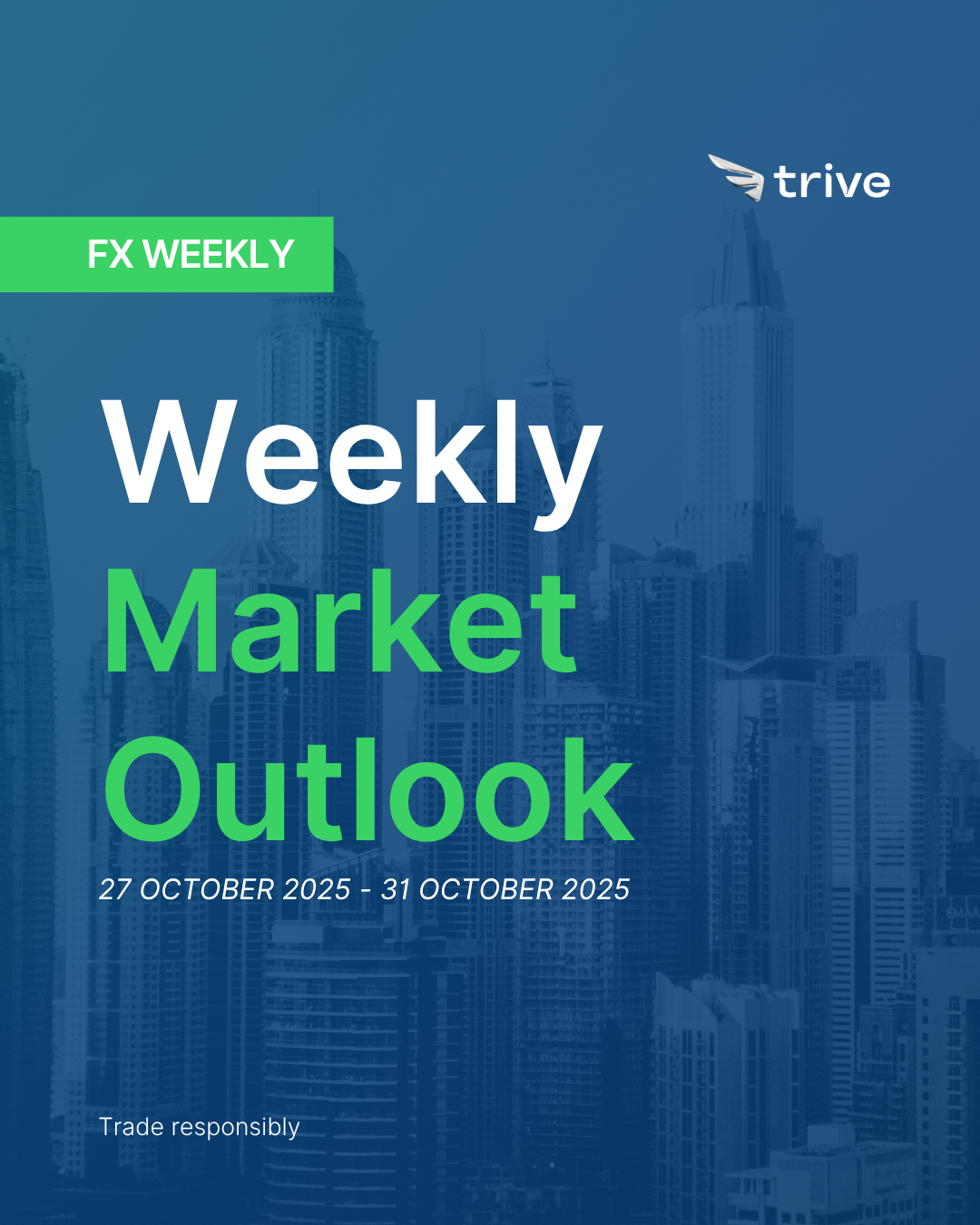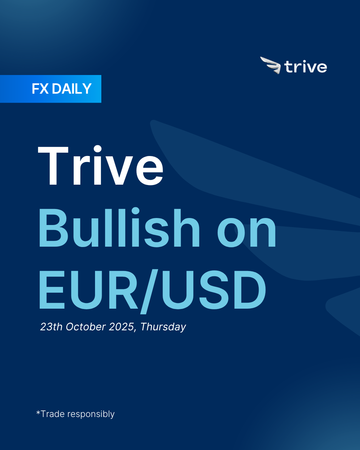FX Weekly: Trive’s Week Ahead Views

This week highlights include US-China trade talks, rate decisions from the Fed, BoC, BoJ and ECB, while Australian CPI and Chinese PMIs will also be key.
Monday
There are currently no expectations for September’s Chinese Industrial Profits. The prior release showed profits surging 20.4% Y/Y in August, the largest jump since November 2023, reversing three consecutive months of decline. The rebound was driven by Beijing’s efforts to rein in excess supply and reduce price wars, alongside favourable base effects and a marginal improvement in producer prices. Analysts note the recovery remains uneven amid soft domestic demand, housing weakness, and ongoing deflationary pressure, with policymakers expected to maintain gradual consolidation and further fiscal support to sustain profitability ahead of China’s next five-year plan.
Wednesday
The FOMC’s October meeting is expected to deliver a 25bps rate cut to 3.75-4.00%, with a further reduction anticipated in December, according to a Reuters poll. Money markets are fully pricing a 25bps cut and are pricing a very high chance of a December reduction. The October decision is likely to be driven by a softening labour market despite elevated inflation pressures, with policymakers divided between prioritising jobs or inflation. Delayed government data obscures the full economic picture. There will also be attention on the balance sheet; some analysts now expect the Fed to end its balance sheet runoff at the October confab, citing recent money market turbulence that could threaten interest rate control. While some foresee a gradual wrap-up, others anticipate a full halt, with mortgage bonds likely to continue running off slowly due to housing market conditions. Ahead, analysts are expecting further rate cuts next year, though there is a degree of uncertainty regarding the magnitude.
In Canada, the BoC is expected to cut rates to 2.25%, according to 23/34 economists surveyed, with the remaining 11 forecasting a hold. At the prior meeting, the BOC abandoned forward guidance, and Macklem said the bank will be making its decisions on a shorter horizon than usual as it assesses incoming data. The jobs report was strong while inflation was hot. The Consumer Outlook survey warned of inflationary pressures while views of the labour market deteriorated. The Business Outlook Survey was subdued on the outlook, with firms expecting cost increases due to tariffs, but inflation expectations are off earlier peaks. However, on trade, there has been a deterioration with the US. President Trump responded to an anti-tariff advert from Ontario by terminating all trade talks with Canada immediately. This saw money market prices bolster rate cut bets with 25bps now fully priced for next week's meeting. This meeting will also see the latest MPR, and alongside economic forecasts, the BoC may return to offering a baseline forecast, while eyes on the neutral rate estimate will also be eyed with rates now below the midpoint of the BoC's neutral rate range.
In Australia, there are currently no median expectations for the release. Westpac forecasts Q3 headline CPI at 1.1% Q/Q (prev. 0.7%) and Trimmed Mean at 0.8% Q/Q (prev. 0.6%). The August Monthly CPI printed at 3.0% Y/Y (prev. 2.8%), broadly in line with Westpac’s view despite a larger-than-expected fall in electricity prices. Offsetting gains across other components allowed the bank to maintain its Q3 forecast. Westpac notes that key categories such as rents (+0.9% Q/Q) and new dwellings (+1.0% Q/Q) sit within the core inflation range, implying any upside surprise would lift underlying measures. The bank “estimate[s] the RBA is expecting 0.6%qtr for the next two quarters to get their end-year estimate of 2.6%yr.”, though Westpac cautions that housing-related components pose a mild upside risk to core inflation.
Thursday
US President Trump will meet Chinese President Xi on October 30th during the APEC Summit in South Korea. The talks aim to de-escalate tensions and potentially resume trade negotiations, focusing on rare earths, soybeans, fentanyl, technology exports, and Taiwan. Analysts describe the mood as cautious, with both sides seeking a 'reset' but unlikely to make major concessions. The meeting comes amid a fragile trade truce set to expire on November 10th, threatened by new tariffs, export controls, and previous disputes over agricultural purchases, technology, and geopolitical issues. US is preparing a Section 301 investigation into China’s compliance with the 2020 trade deal, potentially leading to additional tariffs as early as November 1st. The talks are seen as a high-stakes step toward stabilising relations and preparing for potential trade agreements in early 2026.
In Japan, the BoJ is likely to keep rates unchanged at 0.50%, with money markets heavily pricing the likelihood of the central bank holding off from hiking rates. Note, a recent report outlined that the BoJ is said to be closer to a hike, but with little need to rush and sees no urgency to hike at this point. As a reminder, the BoJ kept rates unchanged in September, as widely expected, with the decision made by a 7-2 vote in which members Takata and Tamura proposed a 25bps rate hike. Nonetheless, the central bank surprised markets with the announcement to begin selling its ETF and J-REIT Holdings at a pace of JPY 330bln per year and JPY 5bln per year, respectively, with the decision on ETF and J-REIT sales made by unanimous vote. The main development since then was the change of leadership in Japan, where Abe protege Takaichi won the LDP leadership before going on to win the PM vote, after the LDP formed a coalition with the Japan Innovation Party. As such, the political uncertainty caused by the change of leadership that began with former PM Ishiba’s announcement to step down and which resulted in the collapse of a 26-year LDP-Komeito coalition, was seen to likely delay the BoJ from resuming its rate hiking cycle. This remains the view under a Takaichi government. Nonetheless, the prospects of a hike in the near-term are not off the table with one of Takaichi’s closest advisers recently noting that she would likely tolerate another 25bps interest rate hike by January next year if the economy is in firm shape, but caveated that such a move would be on condition the BoJ maintains relatively loose monetary policy with no further rate hikes likely until 2027. The BoJ will also be releasing its latest Outlook Report at next week’s meeting, containing board members’ median projections for Real GDP and Core CPI, while a recent source report noted the BoJ is likely to maintain the view that the economy is on course for a moderate recovery, despite headwinds from US tariffs, and may slightly revise up economic growth forecast for FY25.
In addition, the ECB is expected to maintain policy conditions in October, with all respondents to Reuters forecasting an unchanged outcome and market pricing implying just a 2% chance of a cut from the current 2.00% Deposit Rate. As a reminder, the September meeting saw policy conditions maintained and the reiteration of a meeting-by-meeting and data-dependent approach, whilst not pre-committing to a particular policy path. The most pertinent part of the release was the 2026 inflation view, which was revised to just 1.7% (prev. 1.6%), shy of the 1.9% consensus; a forecast that sparked a dovish reaction. Thereafter, Lagarde unwound some of that by saying minimal deviations would not necessarily justify a move; furthermore, she upgraded the risk assessment to “more balanced” from "tilted to the downside”. Since nothing has occurred to change the narrative of a hold in October, and then the ECB potentially revisiting conditions in December alongside the next set of forecasts. One point of note to look out for will be any view on the direction of the next move, as some officials have outlined the possibility that a hike could occur as easily as a cut. Main policy aside, any commentary around TPI will be keenly sought, given the recent downgrade to France following another bout of political turmoil. However, this may not feature until the Q&A, as spreads remained orderly throughout that period. Overall, the ECB is seemingly still in a good place on policy, and as such, there is no need to deviate at this point, though December could bring a cut depending on the evolution of data. On that, the EZ Flash HICP series for October prints the session after the October policy announcement.
In the US, if the government shutdown remains in effect, the prelim Q3 GDP data is unlikely to be released. Still, the Atlanta Fed's GDPnow tracking estimate is modelling Q3 growth of 3.9%, firming slightly vs the 3.8% in Q2. Goldman Sachs chief economist Jan Hatzius has warned that market forecasts for US GDP may be overly optimistic, as government shutdown-related data gaps could depress employment figures. He notes that Q2 and Q3 GDP estimates of 3.8% and 3.3% may overstate growth, with labour market weakness likely to challenge the positive outlook. S&P Global has previously estimated that the shutdown could trim US GDP growth by 0.1-0.2% every week.
Friday
There are currently no expectations for the Japanese Tokyo CPI, which is seen as a precursor to the nationwide CPI release, usually a couple of weeks later. The release comes a day after the BoJ announcement where the central bank is likely to keep rates unchanged at 0.50%, with money markets heavily pricing the likelihood of the central bank to hold off from hiking rates, while a recent report noted that the BoJ is said to be closer to rate hike, but with little need to rush and is said to see no urgency to hike rates next week. The latest nationwide CPI showed headline and core inflation both rising to 2.9% Y/Y in September (prev. 2.7%), marking the first acceleration since May, while the core-core gauge eased to 3.0% from 3.3%. Headline CPI has now exceeded the BoJ’s 2% target for 41 consecutive months, since April 2022. The upcoming Tokyo release will offer an early gauge of whether price momentum is stabilising or reaccelerating ahead of year-end policy considerations.
Disclaimer
This material is provided for informational purposes only and does not constitute financial, investment, or other advice. The opinions expressed in this material are those of the author and do not necessarily reflect the views of Trive International. No opinion contained in this material constitutes a recommendation by Trive International or its author regarding any particular investment, transaction, or investment strategy. This material should not be relied upon in making any investment decision.
The information provided does not consider the individual investment objectives, financial situation, or needs of any specific investor. Investors should seek independent financial advice tailored to their individual circumstances before making any investment decisions. Trive International shall not be liable for any loss, damage, or injury arising directly or indirectly from the use of this information or from any action or decision taken as a result of using this material.
Trive International may or may not have a financial interest in the companies or securities mentioned. The value of investments may fluctuate, and investors may not get back the amount they originally invested. Past performance is not indicative of future results.
For more information about Trive International, please visit http://trive.com/int
Additional Information
Investing involves risk, including the potential loss of principal. Diversification and asset allocation strategies do not ensure a profit or guarantee against loss. The content in this material is subject to change without notice and may become outdated or inaccurate over time. Trive International does not undertake any obligation to update the information in this material.
By accessing this material, you acknowledge and agree to the terms of this disclaimer. If you do not agree with these terms, please refrain from using this information.
No comments
Home
Trive
TriveHub




0 comments